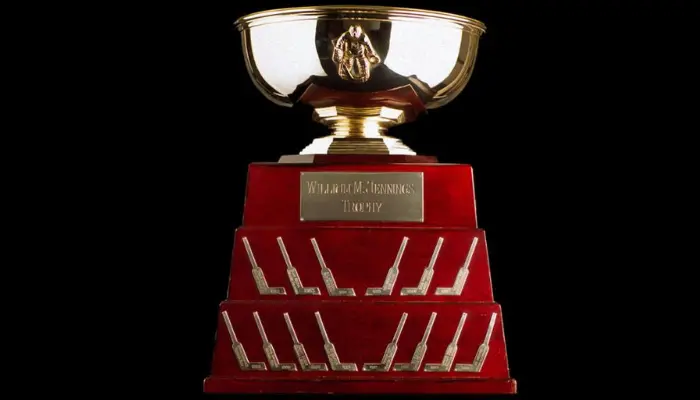If you are a fan of hockey or if you want to play hockey as a beginner, you will have to learn all the rules and regulations of hockey. When it comes to the goalie, is the trickiest and most challenging position in hockey. For this position, you will have to understand all the terms that are a bit difficult to remember as compared to other terms.
To play like a professional, you must be capable of comprehending all the tricks used by hockey experts. The hockey goalies’ terms include angles, backdoor, backstop, back-up goaltender, blocker, brick wall, butterfly, cage, chest protector, crease, face mask, and many more.
So, you will learn a few of the more specialized goaltender terms in this blog post. Also, you will get some additional knowledge about hockey terms. Let’s have a look at them.
A Dictionary of Hockey Goalie Slang
Below is the list of ice hockey goalie terms and definitions that you will have to learn before going to play hockey:
- Angles: A goaltender will set up in such a way that the area of the net will be reduced so that a striker can view.
- Backdoor: The blank part of the net that the goaltender is not shielding when he is at one end of the net is known as the backdoor.
- Backstop: The backstop is another term that is used for the goalkeeper.
- Back-up Goaltender: The goalie who is on the team’s sideline but is not involved in the game is known as a backup goaltender.
- Between the Pipes: Another term for the goalkeeper net is “between the pipes,” and it refers to a goalkeeper who is positioned in his crease.
- Blocker: The huge glove that the goalkeeper uses on the hand grips his hockey stick and has a flap on the side.
- Brick Wall: A goalkeeper who stops every ball that is fired at him is referred to as a “brick wall” because it appears in a way that is in front of the net. This works well to fill the bottom of the netting.
- Butterfly: The most typical goalkeeper stance is known as the butterfly. It is utilized when the goaltender is playing defense or attempting to stop a weak shot from close range.
- Cage: It is the goalkeeper’s helmet to cover the head and face from injury.
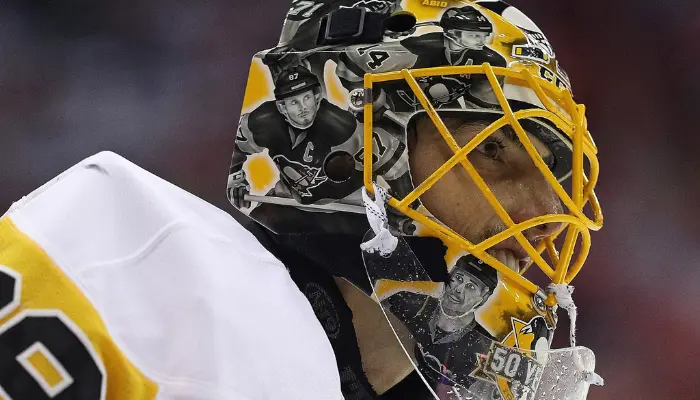
- Chest Protector: A goaltender uses a massive chunk of cushioning and safety over his chest, body, and arms to shield him from the puck.
Related Post: Dump and Chase
- Crease: The goaltender must remain in the crease whether playing defense or taking shots on target. The crease is a boundary marked on the ice immediately between and in front of the goaltender’s goalpost.
- Doorstop: The space in front of the goalie is sometimes known as the “doorstop,” with a player standing in front of the goalpost.
- Face mask: The facial mask is another name for the goalkeeper helmet.
- Five-Hole: The space between the goalkeeper’s legs when he shifts from side to side or from a high to a low position. A player has used his five-hole when a goaltender allows a score between his legs.
- Freeze the Puck: When a goalkeeper covers the puck with his hand or holds it in his legs to halt the play.
- G: In stats, the term “goaltender” is simplified as G.
- GA: Goals Against (GA) is an indicator that denotes the total number of goals that a goalkeeper has allowed in a match.
- GAA: The total number of scores a goaltender allows per game is known as the goals-against average. For instance, if he scores 3 goals in one match and 2 in the next, his total goals-against average will be 2.5, or five points categorized into two matches. The exact analysis considers 60 minutes for each match.
- Glove: The goaltender’s non-stick hand is where he puts the collecting glove.
- Glove-saving circumnavigation: When a goaltender grabs the puck in such a way that his arm ends up making a big ring, it is called glove-saving circumnavigation.
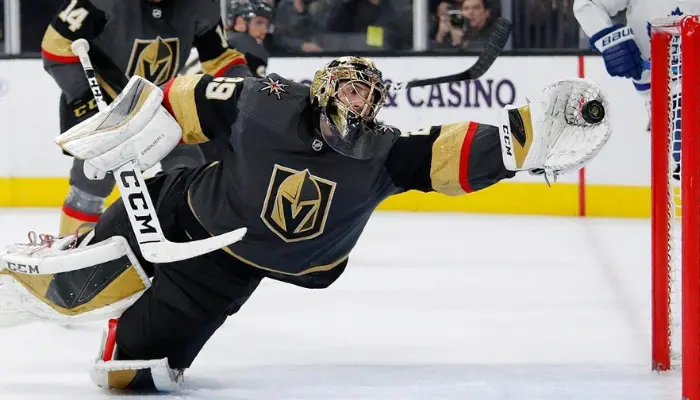
- Goal Crease: The goalkeeper’s region is the colored region in front of the net. It is known as a goal crease.
- Goaltender Interference: A skater receives a punishment if he pushes or strikes the goaltender inside or outside the net.
- Goal Line: The goaltender net is situated on the tiny red border that extends from one side of the posts to the other. A puck must fully pass the goal line and enter the net to be considered a goal.
- Goal Mouth: The region in front of the net also goes by the term, Goal Mouth.
- Goalie Pads: The goalkeeper’s bulky leg protectors serve as both safety and a technique of puck-stopping.
Related Post: What is Icing in Hockey?
- Goalie Stick: The unique kind of stick that a goalkeeper utilizes, which has a large grip is known as the keeper’s or goalie’s stick.
- Goose Egg: Goose egg means achieving a blank or scoring no points against the opposition.
- Hugging the Post: When a goalkeeper is pressed up against the wall so that his arm and leg are in contact with it, it is called hugging the post. It tries to ensure that no puck can pass between them.
- Holes: The regions where players strive to shoot to make the goals that develop between the goalkeeper’s limbs or posts.
- Iron: It is a term for the net’s steel pole.
- Jennings Trophy: The honor is given to the goaltender pair whose squad allows the minimum goals during a national hockey league year.
- Lateral Movement: When a goalkeeper shifts from one end of the net to the opposite or from side to side.
- Mesh: The net encircles the net’s steel frame.
- Net: The fence at every side of the ice arena is known as the net. It holds the goal-scoring posts.
- Netminder: It is a different term for the goalkeeper.
- Number-one Goaltender: The goalkeeper who begins and performs the most matches out of the squad’s two goalies is known as the number-one goaltender.
- Paddle Down: To stop pucks from hitting along the rink, you must make sure the goalkeeper’s stick blade is on the surface.
- Puck: The black and soft rubber puck is used in goal-scoring.
- Pull the Goalie: When a squad adds a striker to the rink at the finish of the match to obtain a goal.
- Razor Sharp: When a goalkeeper is performing well and producing incredibly difficult saves, they are considered to be super sharp.
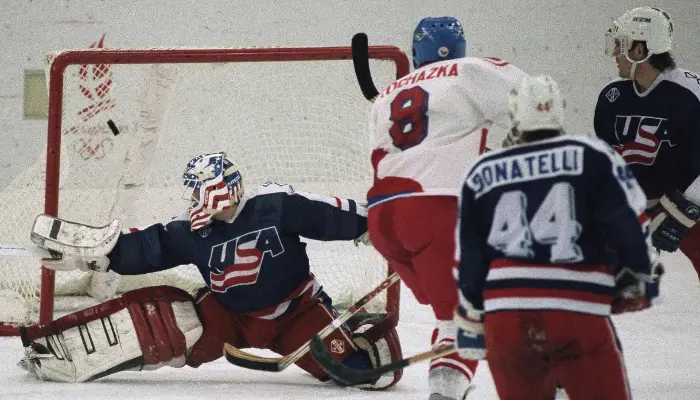
- Rebound: When the puck strikes the goalkeeper and rebounds back into the action, it is said to rebound. The goaltender tries to regulate the length of the bounce or move it toward the rink’s side.
- Red Light: A “red light” will turn on once a score is made to show that the puck has passed the edge of the box.
- Reading the Play: A goaltender is watching the puck and trying to predict where it will travel and when it will be hit on goal when watching a game. It is known as reading the play.
- Ricochet: When a puck bounces off a few skates, sticks, legs, or other parts of the body, the term “ricochet” is used.
- Roof: The net’s upper portion is called the Roof.
- Save: When a puck is fired at the goaltender, the goalkeeper makes a save to keep the puck out of the goal.
- Save Percentage: The number of saves a goaltender performs is multiplied by the total number of shots and it is known as the save percentage. A goaltender will have a. 900 or 90% save ratio if he prevents 9 out of 10 goals.
- Screen: When a player is blocking the goalkeeper’s view of the incoming puck or shot, the term “screen” is used.
- Shutout: A shutout occurs when a goalkeeper allows no goals throughout the entire match.
- Sieve: A goaltender who is struggling and conceding a large number of goals that could have been stopped. It is called a sieve.
- Slot: The region in front of the net that stretches from the bottom of the crease to the height of the face is known as the “slot.”
- Square to the puck: Goalkeeper placement is where he will be pointing directly at a striker. It will give the shooter the fewest number of the net to fire at where he is standing on the rink.
- Stacking the Pads: When the goaltender is on the rink and stacks his two goalkeeper pads to prevent a shot, he is on his side.
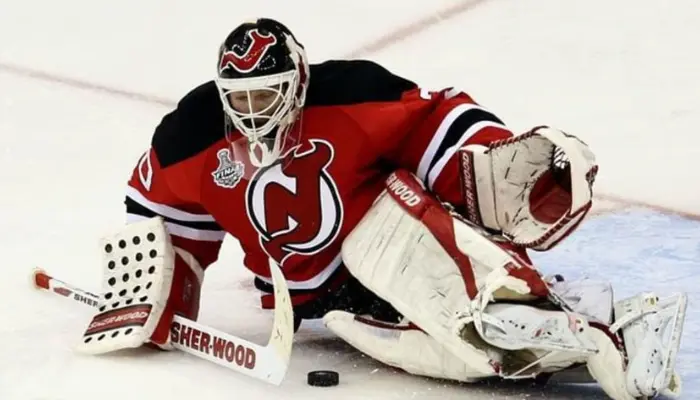
- Stick: The three components of a hockey stick are the blade, shaft, and handle. They are all joined together by bolts or sticky tape. The blade transfers force into shots.
- Stand on his Head: A goaltender who often makes incredible saves for the opposing team is known by this term.
- Stone a Shooter: When a goaltender prevents a shooter who has a strong opportunity to score, the term “stone a shooter” is used.
- Trapezoid: When the puck crosses the end zone and travels to the end line, the goaltender is permitted to play it in the trapezoid region behind the goal.
- Trapper: Trapper is the goalkeeper glove’s conventional name.
- Undressed: When a goaltender loses the puck or is deceived into conceding a goal by a skater, this is called undressed.
- Vezina Trophy: The Vezina Trophy is given to the goaltender who has the finest season in the NHL.
Related Post: The Top 10 Greatest American Hockey Players
- Partner: The teammate who is closest to the goaltender and typically nearest to the net is known as the goalkeeper’s partner.
- Bounce: A puck in hockey that is deflected by a player or goalie commonly “bounces” once before hitting in. This occurs because hockey pucks are more spherical than conventional football or soccer balls.
- Snap Shot: A skater who is moving freely can take a rapid, close-range shot known as a snapshot. They employ this style of shot to get past goalie opponents or to score into an open net.
- Puck Hit: A “puck hit” occurs when a skater is smacked or pushed while going to handle or move the puck. Umpires can designate you for interfering if you take repeated “puck hits.” It could lead to a penalty shootout for your squad.
- Wrist Shot: A wrist shot is a swift and powerful slap shot that is executed by first throwing the ball with your hand and then forcefully striking it with the blade of your sticks to throw it into the air.
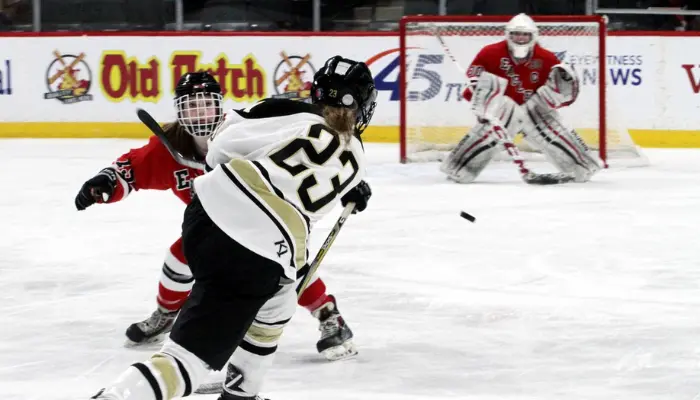
- Blue Line: This is the portion of the ice in front of your goal, and your team’s defensemen typically guard it.
- Body Position: Your body’s position, particularly when you are diving to attempt a save, can affect your ability to succeed. To give yourself more time to respond, you must try to maintain as much distance as you can from the target.
Conclusion: List of 50+ Ice Hockey Goalie Terms and Definitions
I have described a collection of more than 60+ ice hockey goalie terms and regulations in this post that is essential to know to play. From crease to blocking area, all the terms are essential to understand to have a better hockey experience.


